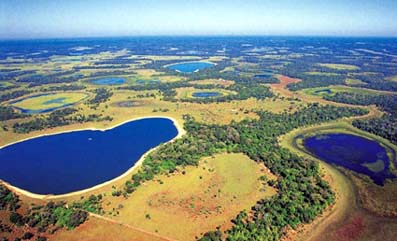 |
The Amazon may have all the fame and glory, but the Brazilian Pantanal is a far better place to see wildlife. This vast area of wetlands is about half the size of France. The word Pantanal comes from Pantano, which means swamp or marsh. Birds are the most frequently seen wildlife, but Pantanal is also a sanctuary for giant river otters, anacondas, iguanas, jaguars, cougars, crocodiles and deers. |
The biodiversity of the region is extremely rich. 260 species of fish and 650 species of birds live here. Spectacled Cayman, Hyacinth Macaw, Rhea, Giant River Otter, Tapir and Jaguar all call this home. In addition to monkeys, emus, and alligators, many snake species also live there. Thousands of birds such as Ibises, storks, jaburus, and spoonbill populate the area, and it is also an important wintering area for millions of migratory birds from North America. The Pantanal is also home to the New World's largest concentration of large animals with the variety comparable to that seen in Africa. |
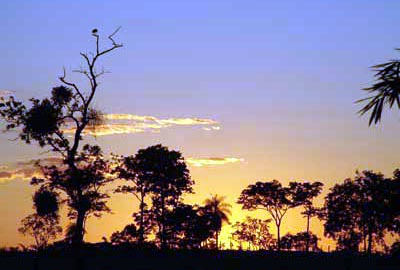 |
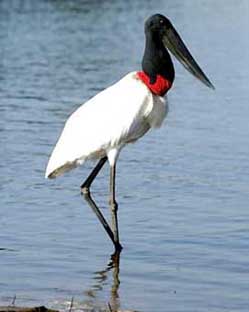 |
If you want to go deeper into Pantanal you will need to join a boat tour. Large boats trips can be easily arranged at Corumba as well as at other main cities in the area. The most exciting part of those trips are on board the small canoes, where you can really feel that Pantanal Excitement, a mix of water, jungle, fauna and flora. At Pantanal the water levels rise significantly during the rainy season from November through the beginning of April. Then, from May to October, the water levels begin to lower, and what were lakes, gradually diminish to small ponds, and then to mere puddles. Therefore, if you are interested in birdwatching, this is your time. At left, a Tuiuiu, Pantanal most representative bird. |
We visited the Pantanal during a four days tour, and that was just enough for glimpse of it all. The area has few people and just small towns and villages. Access to it is often by large planes to the mais cities of Cuiaba, Campo Grande or Corumba, then overland or by small planes to the gateway towns. Most of the Pantanal lies in the floodplain of the Paraguai river and its tributaries. The terrain here is flat, with gently sloping and meandering rivers that flood during the annual wet season, submerging over 80 percent of the area. Therefore we found a lot of small bridges like the one at right. |
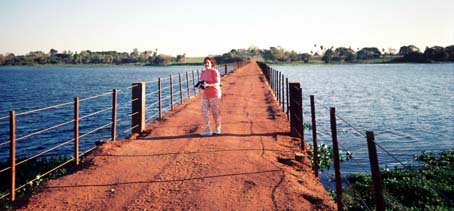 |
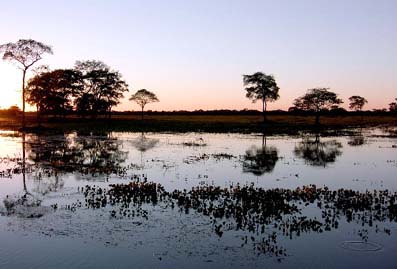 |
Tipical Pantanal scene, taken at the end of the afternoon. |
San Francisco Church, at Campo Grande city, the large capital city of Mato Grosso do Sul state. If you start your Pantanal tour at this city, do not miss some of its main attractions, like Dom Bosco Museum, Parque das Nacoes Indigenas (Indian Nation Park), and Horto Florestal (wildlife park). Oh yes, there is also shopping at the Pantanal, at Shopping Campo Grande, where you will find large shops, restaurants, movies, and all that usual mall stuff. Oh yes, one of the favorite activies in Pantanal is alligator watching. |
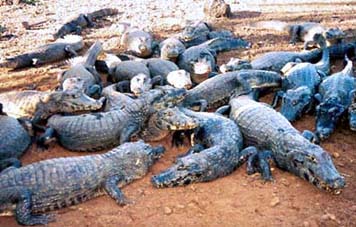 |
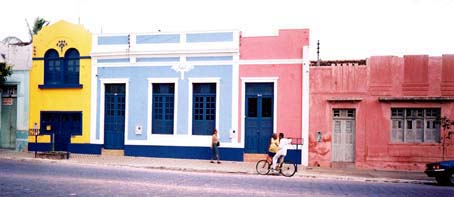 |
A colorfull shot of colorfull city, the main gateway to Pantanal, where we spent one night. Despite the picturesque look of this street, Corumba is actually a large town. Known as the White City, thanks to the predominantly clear color of the ground, it offers good choices of hotels, restaurants and many tours to the Pantanal. |
Along a secundary road west from Corumba we faced some delays on our jorney thanks to some slow driving friends ahead of us.... The majority of the landowners in the southern lowlands region of Pantanal rely on cattle grazing as their major means of income. Approximately 80% of Pantanal limits are within Brazil and spans throughout the states of Mato Grosso and Mato Grosso do Sul, encompassing river, forests, perennial wetlands and lakes, seasonally inundated grasslands and terrestrial forests. |
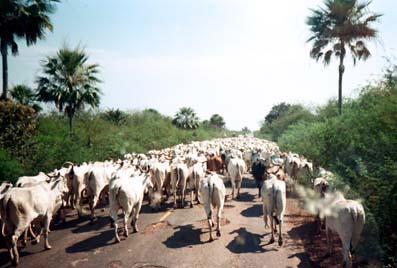 |
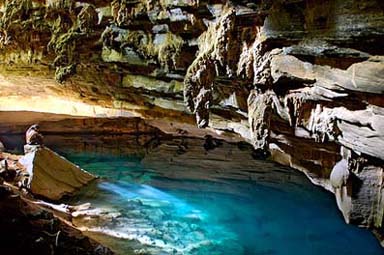 |
The city of Bonito is one of the most famous locations inside the Pantanal, and no tour would be complete without a visit to it. Bonito serves as the starting point to a large number of tours that usually include swiming and diving at Pantanal's many crystal lakes. Pantanal vegetation is mainly a mixture between three of the most important eco-systems of south america; the Chaco with its dry forest formations to the south, the savanna-like Cerrado to the east and the Amazon jungle to the north. This mixture has caused the Pantanal to house the highest concentration of wildlife in the Americas. At left, Bonito's, Gruta Azul (Blue Cave). |
Me at the entrance door of an old army fort, located at Brazil-Bolivia frontier. Pantanal is one of the last refuges for many threatened South American mammal species such as jaguar, puma, ocelot, manned wolf, giant otter, giant anteater, giant armadillo, marsh deer (the biggest deer of South America), peccary (the south American wild pig) and tapir. The most characteristic mammal of the Pantanal is the Capivara (the world's largest rodent up to 70 kg), that can be observed during the dry season in herds of up to 100 individuals. |
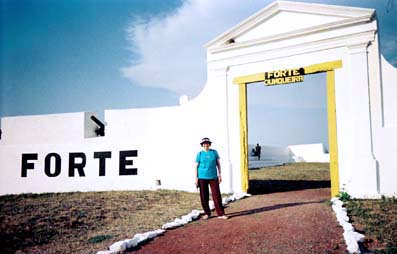
|
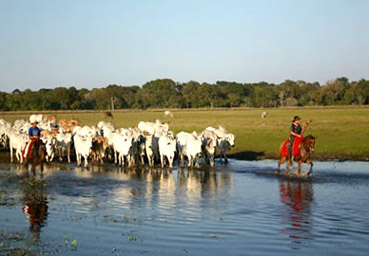 |
The many rivers and lakes of the Pantanal sustain a varied fish life of at least 260 species including several species of Piranha as well as catfish of up to 120 kg. A large part of the Pantanal area is privately owned land consisting of Fazendas, large cattle ranches. In recent years the grasslands have fed up to 8 million head of cattle, and the world Pantaneiro refers to the Cowboy from the Pantanal. |
|
Aerial view from Pantanal, taken at a low level flight. |
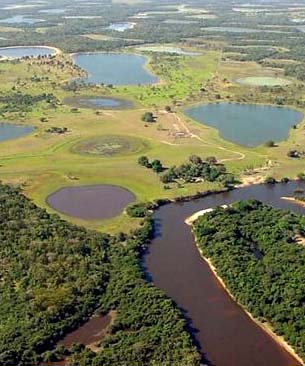 |
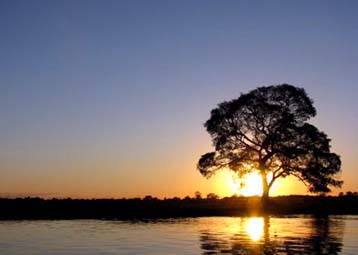 |
Sunset at Pantanal. Silence is golden, all you hear is the sound of the birds and animals. |
Pantanal is a sanctuary for birds with many species occurring in large numbers. It is one of the most important breeding grounds for typical wetland birds such as Jaburu (left), ibis and ducks. Parrots are also very diverse, with 26 species recorded in the area. If you decide to visit this Pantanal Wetland paradise, we suggest booking with a good travel agency to get the most of your visit. And visit also Caiman, where you will get detailed information about available tours, birdwatching, lodging and much more. We are sure you will enjoy Pantanal as the adventure of a lifetime! |
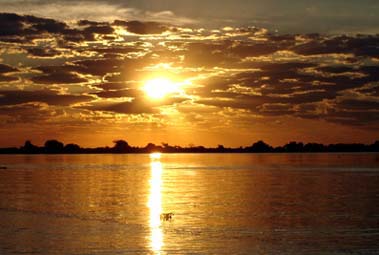 |
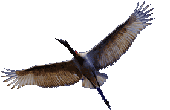
A flying Tuiuiu
|
|
|